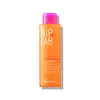What's inside
What's inside
 Key Ingredients
Key Ingredients

 Benefits
Benefits

 Concerns
Concerns

No concerns
 Ingredients Side-by-side
Ingredients Side-by-side

Water
Skin ConditioningGlycerin
HumectantButylene Glycol
HumectantLactic Acid
BufferingPolysorbate 20
EmulsifyingPhenoxyethanol
PreservativeAscorbic Acid
AntioxidantBenzyl Alcohol
PerfumingSodium Hydroxide
BufferingParfum
MaskingDisodium EDTA
Panthenol
Skin ConditioningSodium Sulfite
PreservativeEthylhexylglycerin
Skin Conditioning1-Methylhydantoin-2-Imide
Skin ConditioningDehydroacetic Acid
PreservativeLimonene
PerfumingCamellia Sinensis Leaf Extract
AntimicrobialCoffea Arabica Seed Extract
MaskingEuterpe Oleracea Fruit Extract
Garcinia Mangostana Fruit Extract
Skin ConditioningHydrolyzed Lycium Barbarum Fruit Extract
AntioxidantMorinda Citrifolia Fruit Extract
Skin ConditioningPunica Granatum Fruit Juice
MaskingWater, Glycerin, Butylene Glycol, Lactic Acid, Polysorbate 20, Phenoxyethanol, Ascorbic Acid, Benzyl Alcohol, Sodium Hydroxide, Parfum, Disodium EDTA, Panthenol, Sodium Sulfite, Ethylhexylglycerin, 1-Methylhydantoin-2-Imide, Dehydroacetic Acid, Limonene, Camellia Sinensis Leaf Extract, Coffea Arabica Seed Extract, Euterpe Oleracea Fruit Extract, Garcinia Mangostana Fruit Extract, Hydrolyzed Lycium Barbarum Fruit Extract, Morinda Citrifolia Fruit Extract, Punica Granatum Fruit Juice
Water
Skin ConditioningGlycerin
HumectantAvocado Oil Polyglyceryl-6 Esters
EmollientHydroxyethyl Acrylate/Sodium Acryloyldimethyl Taurate Copolymer
Emulsion StabilisingPanthenol
Skin ConditioningPhenoxyethanol
PreservativeCaprylic/Capric Triglyceride
MaskingAlpha-Glucan Oligosaccharide
CleansingMaltodextrin
AbsorbentSorbitan Isostearate
EmulsifyingPolysorbate 60
EmulsifyingGluconolactone
Skin ConditioningEthylhexylglycerin
Skin ConditioningDisodium EDTA
Biosaccharide Gum-1
HumectantTasmannia Lanceolata Leaf Extract
Skin ConditioningSyzygium Luehmannii Fruit Extract
AntioxidantKunzea Pomifera Fruit Extract
Skin ConditioningWater, Glycerin, Avocado Oil Polyglyceryl-6 Esters, Hydroxyethyl Acrylate/Sodium Acryloyldimethyl Taurate Copolymer, Panthenol, Phenoxyethanol, Caprylic/Capric Triglyceride, Alpha-Glucan Oligosaccharide, Maltodextrin, Sorbitan Isostearate, Polysorbate 60, Gluconolactone, Ethylhexylglycerin, Disodium EDTA, Biosaccharide Gum-1, Tasmannia Lanceolata Leaf Extract, Syzygium Luehmannii Fruit Extract, Kunzea Pomifera Fruit Extract
Ingredients Explained
These ingredients are found in both products.
Ingredients higher up in an ingredient list are typically present in a larger amount.
Disodium EDTA plays a role in making products more stable by aiding other preservatives.
It is a chelating agent, meaning it neutralizes metal ions that may be found in a product.
Disodium EDTA is a salt of edetic acid and is found to be safe in cosmetic ingredients.
Learn more about Disodium EDTAEthylhexylglycerin (we can't pronounce this either) is commonly used as a preservative and skin softener. It is derived from glyceryl.
You might see Ethylhexylglycerin often paired with other preservatives such as phenoxyethanol. Ethylhexylglycerin has been found to increase the effectiveness of these other preservatives.
Glycerin is already naturally found in your skin. It helps moisturize and protect your skin.
A study from 2016 found glycerin to be more effective as a humectant than AHAs and hyaluronic acid.
As a humectant, it helps the skin stay hydrated by pulling moisture to your skin. The low molecular weight of glycerin allows it to pull moisture into the deeper layers of your skin.
Hydrated skin improves your skin barrier; Your skin barrier helps protect against irritants and bacteria.
Glycerin has also been found to have antimicrobial and antiviral properties. Due to these properties, glycerin is often used in wound and burn treatments.
In cosmetics, glycerin is usually derived from plants such as soybean or palm. However, it can also be sourced from animals, such as tallow or animal fat.
This ingredient is organic, colorless, odorless, and non-toxic.
Glycerin is the name for this ingredient in American English. British English uses Glycerol/Glycerine.
Learn more about GlycerinPanthenol is a common ingredient that helps hydrate and soothe the skin. It is found naturally in our skin and hair.
There are two forms of panthenol: D and L.
D-panthenol is also known as dexpanthenol. Most cosmetics use dexpanthenol or a mixture of D and L-panthenol.
Panthenol is famous due to its ability to go deeper into the skin's layers. Using this ingredient has numerous pros (and no cons):
Like hyaluronic acid, panthenol is a humectant. Humectants are able to bind and hold large amounts of water to keep skin hydrated.
This ingredient works well for wound healing. It works by increasing tissue in the wound and helps close open wounds.
Once oxidized, panthenol converts to pantothenic acid. Panthothenic acid is found in all living cells.
This ingredient is also referred to as pro-vitamin B5.
Learn more about PanthenolPhenoxyethanol is a preservative that has germicide, antimicrobial, and aromatic properties. Studies show that phenoxyethanol can prevent microbial growth. By itself, it has a scent that is similar to that of a rose.
It's often used in formulations along with Caprylyl Glycol to preserve the shelf life of products.
Water. It's the most common cosmetic ingredient of all. You'll usually see it at the top of ingredient lists, meaning that it makes up the largest part of the product.
So why is it so popular? Water most often acts as a solvent - this means that it helps dissolve other ingredients into the formulation.
You'll also recognize water as that liquid we all need to stay alive. If you see this, drink a glass of water. Stay hydrated!
Learn more about Water